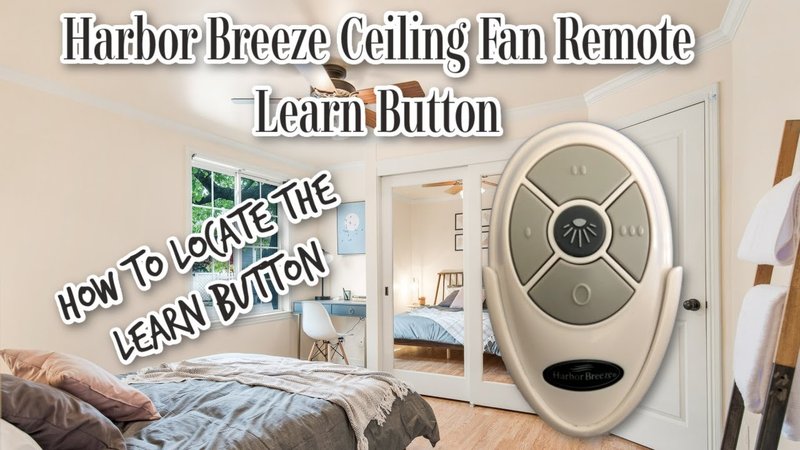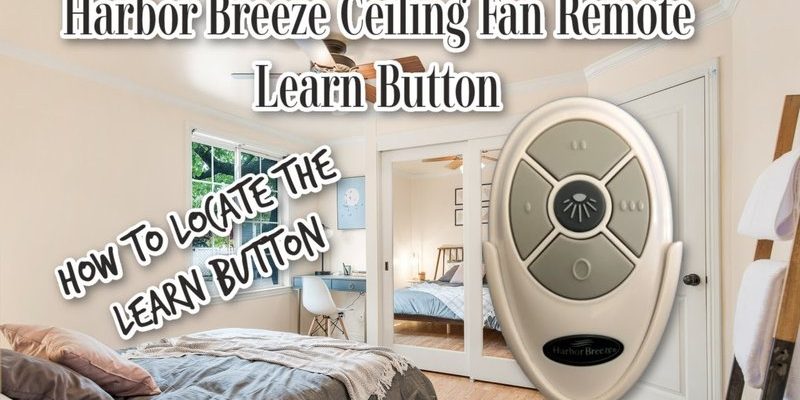
Honestly, I’ve seen folks turn their entire living room upside down looking for the so-called “learn button” after losing sync, swapping batteries, or moving into a new place. It’s like hunting for a hidden passage behind your bookshelf—sometimes it’s there, sometimes it’s not, and sometimes the instructions don’t make much sense. So if you’re unsure whether your Harbor Breeze ceiling fan remote even has a learn button, or how to use it to pair or reset your fan, let’s break it down in plain English.
Understanding Harbor Breeze Ceiling Fan Remotes
Before we get into buttons, codes, or troubleshooting, it helps to understand what kind of remote you actually have. Harbor Breeze, the Lowe’s house brand, makes several types of ceiling fans and remotes. Some models come with simple remotes that only control fan speed and light on/off. Others offer fancy features like dimmers or timers. That means not every remote is built the same—or set up the same way.
Here’s the thing: most Harbor Breeze remotes run on radio frequency (RF), not infrared (IR), so you don’t have to aim them directly at the fan. The remote sends a signal to a receiver inside the fan’s canopy. This design allows you to control the fan from across the room, behind furniture, or even from outside the doorway. But that also means the remote and receiver need to be “paired” or “synced” using special codes, usually set by DIP switches or, in newer models, by pressing a learn button.
If you’re holding a Harbor Breeze remote that feels a bit too high-tech or the packaging says “universal,” you may have a model with extra pairing features. But a lot depends on your fan’s age and which remote type you have.
Is There Really a Learn Button on Harbor Breeze Remotes?
This is where things get confusing. Some Harbor Breeze remotes include a learn button, but many do not. It’s not always labeled clearly, and sometimes it’s not a physical button at all, but a tiny recessed switch requiring a paperclip or pen to press.
If your remote has a button labeled “Learn,” “Pair,” or “Sync,” it’s usually hidden inside the battery compartment. You’ll need to slide off the battery cover and look for a small black or white button, sometimes with a red or blue dot beside it. On other models, you might just see a set of DIP switches—tiny toggles you flip to match the code between remote and receiver.
If you don’t see a learn button, don’t panic. Not all Harbor Breeze ceiling fan remotes use this pairing method. Some only pair by matching the DIP switches, so there’s no need for an extra button.
For anyone who loves a good analogy, think of the learn button as a “first handshake.” It’s what tells your fan, “Hey, this is my remote—please listen to me.” If the remote and receiver don’t shake hands, nothing happens.
How the Learn Button Works: Syncing Remote and Receiver
Let me explain how the learn button is used if your remote has one. Imagine you’ve replaced your batteries, bought a replacement remote, or your fan’s just not responding. The pairing process with a learn button goes something like this:
- First, shut off power to the fan, either at the wall switch or circuit breaker. Give it a few seconds for everything to reset.
- Restore power, then climb up (safely!) to the fan canopy—sometimes the receiver has its own learn button, too. But with Harbor Breeze, you’ll often just use the remote.
- On your remote, open the battery compartment and hold down the learn button for about 3-5 seconds. You may see an LED blink or hear an audible beep from the fan if pairing is successful.
- Test the remote: Try turning the fan on and off, changing speeds, or switching the light. If it works, you’ve paired your remote.
Some models may require you to press the fan’s own reset button or enter a specific code. If your remote doesn’t have a learn button, look for the DIP switches I mentioned earlier, and make sure they match both on the remote and receiver unit.
Troubleshooting Common Harbor Breeze Remote Problems
Pairing issues aren’t always about that mysterious learn button. You might be wondering, “Why doesn’t my ceiling fan listen to my remote at all?” Most of the time, it’s not your fault—it’s usually something simple, like dead batteries or mismatched codes.
Here’s a quick troubleshooting rundown that works for most Harbor Breeze ceiling fans:
- Batteries: Check if your remote’s batteries are fresh and properly installed. Weak batteries can give you random, unreliable results.
- Reset the Remote: If you have a learn button, use it. If not, try flipping the breaker off and on, then test again.
- Check the DIP Switches: Make sure the code set on the tiny DIP switches in the remote matches those on the receiver inside the fan.
- Obstructions: Big metal fixtures or thick walls can interfere with the signal. Move closer and test from different spots.
- Interference: Other RF remotes or devices can cause trouble. Try turning off other electronics to see if that helps.
If your fan still won’t respond, it might be time to check for a bad receiver or remote. Universal remotes compatible with Harbor Breeze fans can sometimes swoop in like a hero, but you’ll likely have to pair them using the same steps—learn button, code, or DIP switches.
Comparing DIP Switch vs. Learn Button Remotes
It’s easy to get lost in the weeds with all these terms. So, what’s the real difference between remotes with a learn button and those with DIP switches?
DIP switch remotes are the old-school kind—like setting a secret password. Open up the remote and receiver, and you’ll see a row of little toggles. Flip them up or down in a matching pattern, and presto, your remote “talks” to your fan. No pairing button involved. The downside? It’s a bit fiddly, and if you move houses or buy a replacement remote, you’ll need to open things up again.
Learn button remotes are more modern. You just hold a button until you get a flash or beep, and the remote does the hard work of connecting. It’s quick, less prone to human error, and you don’t need to mess with tiny switches.
If you’re feeling like a detective with a magnifying glass, don’t worry—it’s not just you. Harbor Breeze has used both systems over the years, so your exact method depends on your model.
Replacing or Upgrading Your Harbor Breeze Ceiling Fan Remote
If your remote’s missing, broken, or just plain stubborn, you’ve got options. Not every replacement remote will have a learn button, but you can often find universal models that will pair with your Harbor Breeze ceiling fan, as long as you follow the right steps.
Before you buy, check what you already have. Is your fan receiver set up for pairing via learn button, or is it a DIP switch model? Universal remotes with learn buttons usually make life easier, but they need a compatible receiver. Some newer Harbor Breeze kits even let you reset and pair remotes with a single button press—much more convenient for renters or folks who misplace things frequently.
Here are a few steps for replacing your ceiling fan remote:
- Identify your fan model, usually found on the motor housing or instruction manual.
- Check your existing remote for DIP switches or a learn button.
- Match your new remote (or kit) to the same pairing method. If it’s a universal remote, follow the included instructions for code entry or syncing.
Sometimes, it may be easier just to replace both the remote and the receiver. A new universal kit designed for Harbor Breeze ceiling fans includes everything you need, and pairing is usually even more straightforward with a learn button system.
When to Call for Help: Harbor Breeze Remote Support
Let’s be real—sometimes, no amount of button pressing or switch flipping gets your ceiling fan spinning again. If you’ve reset, replaced batteries, checked codes, and tried the learn button (if you have one), it might be time to call in some backup.
Harbor Breeze support is available through Lowe’s customer service. If you’re still under warranty, you may get a replacement remote or receiver at no cost. Before you call, have your fan’s model number, purchase date, and your troubleshooting notes handy. Customer support reps can walk you through syncing or resetting steps, or recommend the right replacement part.
If you’re handy, you might be able to swap out faulty parts yourself. But for hardwired fans or complex installs, there’s no shame in hiring a professional electrician—sometimes, peace of mind is worth the extra expense.
What To Do If Your Remote Doesn’t Have a Learn Button
You might be staring at your Harbor Breeze remote, thinking, “So what now?” If your remote doesn’t have a learn button, you’re not out of luck. Here’s what to try:
- Open your remote and look for DIP switches; match them with the receiver.
- If you’re still not sure, check your user manual or look up your model online. Harbor Breeze has a pretty diverse range of remotes and pairing methods.
- If your remote’s pairing method just isn’t working, consider a universal remote/receiver kit as your next step. It’s often easier and less stressful than endless troubleshooting.
If you’re renting or living in a shared space, double-check that you have access to the fan canopy before changing anything. Sometimes, the receiver is tucked away and not easy to reach.
Sorting out whether your Harbor Breeze ceiling fan remote has a learn button can feel a bit like solving a small household mystery. Different models use different methods—some hide a learn button in the battery compartment, while others rely on DIP switches or matching codes. The good news? Once you know what you’re working with, pairing or resetting your remote is usually a quick fix.
Don’t be afraid to check your manual, peek inside the battery compartment, or open the fan canopy if you’re comfortable doing so. Whether your Harbor Breeze remote uses a learn button or not, you’ve got a clear path to syncing, resetting, or even upgrading your control. And if all else fails, help from Harbor Breeze support or a universal remote kit is just around the corner. Here’s to cool, breezy days—and no more remote confusion!
